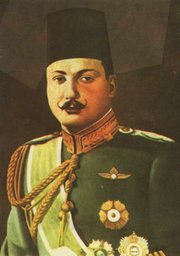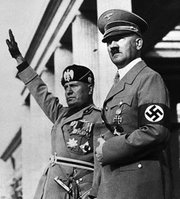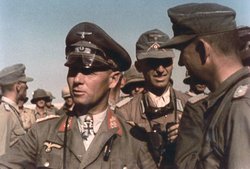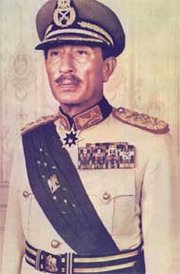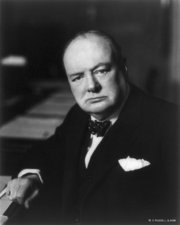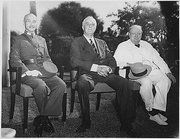Military history of Egypt during World War II
|
|
Military history of Egypt during World War II.
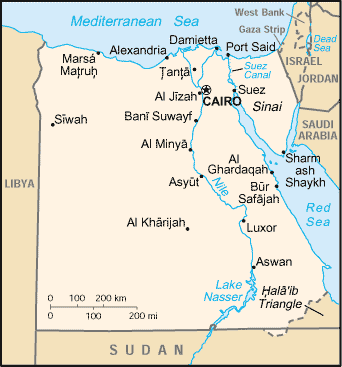
| Contents |
Introduction
In 1882 Egypt became a de facto British colony. This continued until 1922 when Egypt was granted its independence, but British troops remained in the country and true self rule did not occur until 1952 with the rise to power of Colonel Gamal Abdul Nasser.
History of British rule
In 1882 Ahmed Urabi led a revolt of Egyptian military officers and commoners against European and Ottoman domination of Egypt. A British expeditionary force crushed this revolt and while this was meant to be a temporary intervention, British troops stayed in Egypt, marking the beginning of British occupation and the virtual inclusion of Egypt within the British Empire. In deference to growing nationalism, the UK unilaterally declared Egyptian independence in 1922. British influence, however, continued to dominate Egypt's political life and fostered fiscal, administrative, and governmental reforms.
Suez Canal
The strategically vital Suez Canal was completed in 1869 and from that time onwards it had an immediate and dramatic effect on world trade. It played an important role in increasing European penetration of Africa. External debts forced Egypt to sell its share in the canal to the United Kingdom, and British troops moved in to protect it in 1882, controlling the country until 1952. With the outbreak of World War II in 1939, the Axis Powers set their sights on conquering Egypt and controlling the Suez Canal.
Britain's Mediterranean fleet
In the mid-1930s, the headquarters of the British Navy's Mediterranean Fleet was moved from Malta, to Alexandria, Egypt.
Wartime "neutrality"
Although Egypt was technically neutral, Cairo soon became a major military base for the British forces leading up to World War II. This was because of a 1936 treaty by which Britain maintained that it had the right to station troops on Egyptian soil in order to protect the Suez Canal.
King Farouk of Egypt
At this time Egypt was ruled by King Farouk of Egypt, from 1936 until 1952. During the hardships of World War II, criticism was leveled at Farouk for his lavish lifestyle. His decision to keep all the lights burning at his palace in Alexandria, during a time when the city was under blackout due to Italian bombing, particularly angered some. The royal Italian servants of Farouk were not interned and there is an unconfirmed story that Farouk had told Sir Miles Lampson, "I'll get rid of my Italians, when you get rid of yours." This remark was a reference to the ambassador's Italian wife.
After the war, King Farouk brought large numbers of German military and intelligence personnel and ranking ex-Nazis to Egypt as "advisors". The Germans realized Farouk's political weakness and began conspiring with Nasser and the Free Officers Movement who were also working closely with the Muslim Brotherhood, to overthrow Farouk, which finally happened in 1952.
Fascist Italian invasion
In September 1940, Italian dictator Benito Mussolini sent Italian forces stationed in Libya to launch an invasion into British held Egypt and set up defensive forts at Sidi Barrani.
Allied forces, though greatly outnumbered, launched the counter-attack Operation Compass. It was more successful than planned and resulted in massive amounts of Italian prisoners and the advance of the Allied forces up to El Agheila. This stunning defeat of Italian forces did not go unnoticed and soon the Deutsches Afrikakorps, commanded by Erwin Rommel were sent in to reinforce them.
There had been a large Italian community in Cairo prior to the war. Following the June 10, 1940 declaration of war, nearly all of the Italian men were arrested and nearly all Italian property was seized, leaving the women in poverty.
Italian troops had attacked from their colony of Libya into Egypt, which was under British protection, and occupied Sidi Barrani. On December 8 1940 British, and Indian troops under the command of Major-General O'Connor attacked against the Italian rear, via a gap in the defenses south of Sidi Barrani. Planning of the operation (and discovery of the gap) is credited to Brigadier-General Eric Dorman-Smith, who served as an adviser to O'Connor.
Italian defeat
As a counter-espionage measure, many of the British troops involved were not informed that the operation wasn't an exercise, until they were very nearly engaged in combat. The attack was supported by 25 pounder (11 kg) artillery and Blenheim bombers and was centered on the advance of Mk.II Matilda tanks. Within an hour of the onset of combat, Italian General Pietro Maletti would be dead and 4,000 Italian soldiers would surrender. Within three days, 237 artillery, 73 tanks, and 38,300 soldiers would be captured. The attacking forces would move west along the Via della Vittoria, through Halfaya Pass, and capture Fort Capuzzo, Libya.
The attack would eventually continue, ending with the 7th Armoured Division cutting off the Italian retreat. After 10 weeks the British would advance 800 km, destroying 400 tanks and 1,292 artillery pieces and capturing 130,000 POWs. The British would suffer 494 fatalities and 1,225 wounded. However the advance stopped short of driving the Italians out of North Africa. As the advance reached Al Argheila, Churchill ordered that it be stopped, and troops dispatched to defend Greece. A few weeks later the first troops of the German Afrika Korps would begin arriving in Tripoli (Operation Sonnenblume), and the desert war would take a completely different turn. (The Battle of Alamein: Turning Point, World War II p.1-50.)
Nazi German invasion
Adolf Hitler sent his army to North Africa starting in February of 1941 (see Operation Sonnenblume). Nazi Germany's General Erwin Rommel's Deutsches Afrikakorps coming from victories at Tobruk in Libya, and in a classic blitzkrieg, comprehensively outfought British forces. Within weeks the British had been pushed back into Egypt.
German defeat
Rommel's offensive was eventually stopped at the small railway halt of El Alamein, just 60 miles from Cairo. In July 1942 the First Battle of El Alamein was lost by Rommel because he was suffering from the eternal curse of the desert war, long supply lines. The British, with their backs against the wall, were very close to their supplies, and had fresh troops on hand. In early September 1943 Rommel tried again to break through the British lines during the Battle of Alam Halfa. He was decisively stopped by the newly arrived British commander, Lieutenant General Bernard Montgomery.
With British forces from Malta interdicting his supplies at sea, and the massive distances they had to cover in the desert, Rommel could not hold the El Alamein position forever. Still, it took a large set piece battle from late October to early November 1943, the Second Battle of El Alamein to defeat the Germans forcing them to retreat westwards towards Libya and Tunisia.
The German's strategic goal had been to slice through Egypt, capture the Suez Canal, enter the British Mandate of Palestine, subject its Jews to the same Holocaust that was happening in Europe, activate an Arab uprising against the British, and finally link up with German forces thrusting south from the Balkans and Ukraine. The Vichy French forces who were the Nazi's allies, controlled Algeria to the west and Syria to the north of Palestine and were awaiting Nazi triumphs. But all this was foiled by Montomery's victory over Rommel at El Alamein.
In Egypt, there were those Arab leaders, such as Anwar Sadat who actively worked to assist Nazi Germany and were jailed by the British for doing so.
"Young Egypt" movement
The overtly fascist "Young Egypt" (Misr al-Fatah) movement, was founded in October 1933 by the lawyer Ahmed Hussein and was modeled directly on the German Nazi party, with paramilitary Green Shirts, Nazi salute and translations of Nazi slogans.
Major Nazi sympathizers of this era include Ahmad Shukeiri, the first chairman of the PLO; Gamal Abdel Nasser and Anwar Sadat; and the founders of the Pan-Arab socialist Ba'ath Party of Syria and Iraq. "Young Egypt" attracted Nasser and Sadat (who would eventually become Presidents of Egypt).
Anti-British activities
Misr al-Fatah had been in contact with German agents since the 1936-39 Palestine uprising against the British. Sadat and his free officer comrades were in communication with German military intelligence. In the summer of 1942, when Rommel's Afrikakorps stood just over 100 kilometers from Alexandria and were hoping to march into Cairo, Sadat and Nasser were in touch with the Germans. Together with the Muslim Brotherhood in Egypt they planned an uprising in Egypt's capital to expel the British. Arrangements were made for a treaty with Nazi Germany including provisions for German recognition of an independent pro-Axis Egypt, drafted by Sadat, stating that "no British soldier would leave Cairo alive". When Rommel's push east failed at El Alamein in the fall of 1942, Sadat and his co-conspirators were arrested by the British and they sat out the war as prisoners in jail. See:
- Islamism, fascism and terrorism (http://www.atimes.com/atimes/Middle_East/DL04Ak01.html);
- Islam’s Nazi Connections (http://www.frontpagemag.com/articles/ReadArticle.asp?ID=4934);
- 1942-1952, Egpyt: Nasser's Nazis and the CIA (http://64.233.167.104/search?q=cache:0oQFNXdPbZUJ:coat.ncf.ca/our_magazine/links/issue51/articles/51_08.pdf+Sadat+and+Nazi+germany&hl=en&ie=UTF-8).
British victory
The leadership of Britain's General Bernard Montgomery at the Second Battle of El Alamein, or the Battle of Alamein at El Alamein in Egypt, marked a significant turning point of World War II and was the first major victory by a British-led force over the German Army. The battle lasted from October 23 to November 3 1942. Following the First Battle of El Alamein, which had stalled the Axis advance, British general Bernard Montgomery took command of the Eighth Army from Claude Auchinleck in August 1942. Success in the battle turned the tide in the North African Campaign. Some historians believe that the battle, along with the Battle of Stalingrad, were the two major Allied victories that contributed to the eventual defeat of Nazi Germany.
The Situation
By July 1942 the German Afrika Korps under General Erwin Rommel had struck deep into Egypt, threatening the vital British supply line across the Suez Canal. Faced with overextended supply lines and lack of reinforcements and yet well aware of massive Allied reinforcements arriving, Rommel decided to strike at the Allies while their build-up was still not complete. This attack on 30 August 1942 at Alam Halfa failed, and expecting a counterattack by Montgomery´s Eighth Army, the Afrika Korps dug in. After six more weeks of building up forces the Eighth Army was ready to strike. 200,000 men and 1,000 tanks under Montgomery made their move against the 100,000 men and 500 tanks of the Afrika Korps.
The Allied Plan
With Operation Lightfoot, Montgomery hoped to cut two corridors through the Axis minefields in the north. Armour would then pass through and defeat the German armour. Diversionary attacks in the south would keep the rest of the Axis forces from moving northwards. Montgomery expected a twelve-day battle in three stages — "The break-in, the dog-fight and the final break of the enemy."
The Commonwealth forces practised a number of deceptions in the months prior to the battle to wrong-foot the Axis command, not only as to the exact whereabouts of the forthcoming battle, but as to when the battle was likely to occur. This operation was codenamed Operation Bertram. A dummy pipeline was built, stage by stage, the construction of which would lead the Axis to believe the attack would occur much later than it in fact did, and much further south. To further the illusion, dummy tanks made of plywood frames placed over jeeps were constructed and deployed in the south. In a reverse feint, the tanks for battle in the north were disguised as supply lorries by placing a removable plywood superstructure over them.
The Axis were dug-in along two lines, called by the Allies the Oxalic Line and the Pierson Line. They had laid around half a million mines, mainly anti-tank, in what was called the Devil's Garden.
The Battle
The battle opened at 2140 hours on October 23 with an sustained artillery barrage. The initial objective was the Oxalic Line with the armour intending to advance over this and on to the Pierson Line. However the minefields were not yet fully cleared when the assault began.
On the first night, the assault to create the northern corridor fell three miles short of the Pierson line. Further south they had made better progress but were stalled at Miteirya Ridge.
On October 24 the Axis commander, General Stumme (Rommel was on sick leave in Austria), died of a heart-attack while under fire. After a period of confusion while Stumme's body was missing, General Ritter von Thoma took command of the Axis forces. Hitler initially instructed Rommel to remain at home and continue his convalescence but then became alarmed at the deteriorating situation and asked the Desert Fox to return to Africa if he felt able. Rommel left at once and arrived on October 25.
For the Allies in the south, after another abortive assault on the Miteirya Ridge, the attack was abandoned. Montgomery switched the focus of the attack to the north. There was a successful night attack over the 25-26th. Rommel´s immediate counter-attack was without success. The Allies had lost 6,200 men against Axis losses of 2,500, but while Rommel had only 370 tanks fit for action Montgomery still had over 900.
Montgomery felt that the offensive was losing momentum and decided to regroup. There were a number of small actions but, by October 29, the Axis line was still intact. Montgomery was still confident and prepared his forces for Operation Supercharge. The endless small operations and the attrition by the Allied airforce had by then reduced Rommel's effective tank strength to only 102.
The second major Allied offensive of the battle was along the coast, initially to capture the Rahman Track and then take the high ground at Tel el Aqqaqir. The attack began on November 2 1942. By the 3rd Rommel had only 35 tanks fit for action. Despite containing the British advance, the pressure on his forces made a retreat necessary. However the same day Rommel received a "victory or death" message from Hitler, halting the withdrawal. But the Allied pressure was too great, and the German forces had to withdraw on the night of November 3-4. By November 6 the Axis forces were in full retreat and over 30,000 soldiers had surrendered.
Churchill's summation
Winston Churchill famously summed up the battle on 10 November, 1942 with the words "now this is not the end, it is not even the beginning of the end. But it is, perhaps, the end of the beginning."
The battle was Montgomery's greatest triumph. He took the name "Lord Montgomery of Alamein" when he was raised to the peerage.
The Torch landings in Morocco later that month marked the effective end of the Axis threat in North Africa.
1943 Cairo Conference
Following the defeat of the Axis forces, Egypt was safe enough to host the Cairo Conference of November 22-26, 1943, held in Cairo, Egypt. The conference addressed the Allied position against Japan during World War II and made decisions about postwar Asia. The meeting was attended by President Franklin Roosevelt of the United States, Prime Minister Winston Churchill of the United Kingdom, and Generalissimo Chiang Kai-shek of the Republic of China.
The Cairo Declaration
The results were published as the Cairo Declaration, an unsigned press release discussing the Allies' intentions to divide up the Japanese Empire following Japan's surrender. The document vowed to return all territory seized by Japan since World War I and included Taiwan and the Okinawa, as well as Japanese possessions to be returned to China. It also called for Korea to become an independent state.
Roosevelt and Churchill proceeded immediately to the Tehran Conference with Josef Stalin.
External links
- El Alamein (http://www.geocities.com/Pentagon/Quarters/5433/elalamein)
- Text of Cairo Declaration (http://www.yale.edu/lawweb/avalon/wwii/cairo.htm)
References
- [1] The Battle of Alamein: Turning Point, World War II by Bierman and Smith (2002), ISBN 0670030406.
- Alamein by C E Lucas Phillips ISBN 0330300113
| Military history of World War II by nation |
| Britain | China | Egypt | Finland | France | Germany | India | Italy | Japan | Poland | Soviet Union | United States | Australia | Canada | New Zealand |

